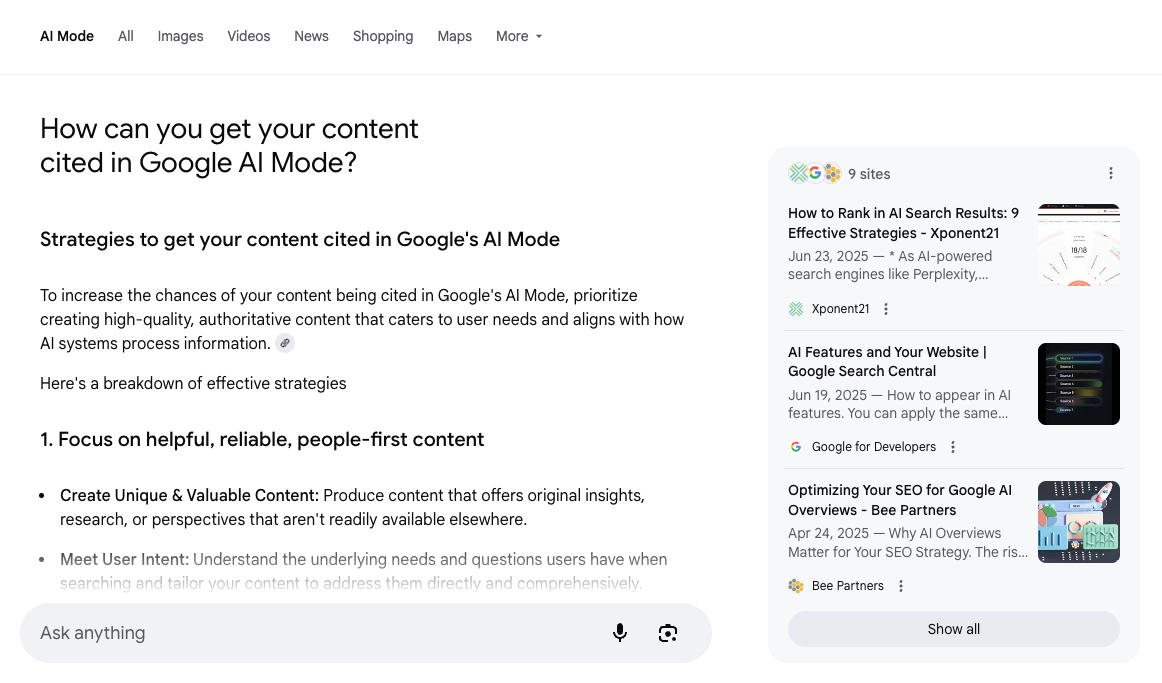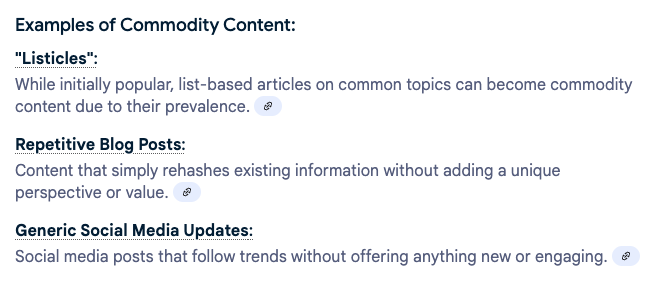
As Google's AI Mode rolls out to more and more users across the globe, it's safe to say we can expect a massive shift in the meaning of the term "search results." The old way – asking questions and clicking on links in hopes they provide the answer we're looking for – is becoming a thing of the past. Instead, the answer is provided in a nicely-organized format, with links, images, maps, and anything else we might need.
To get more information, we can ask follow-up questions to our hearts' content – or click on a link on the sidebar to the right. If you're a marketer, an SEO professional, or a content strategist, that sidebar is where you want to be right now.
The question on your mind, my mind, and basically everyone in the industry's mind: What content types get cited the most on Google AI Mode and AI Overviews? I set out on a quest to find the answers, and the results were surprising. Or were they? I'll let you be the judge of that.
✅ Key Takeaways: Getting Cited on Google AI Mode
Listicles aren't dead – Despite Google's advice against "commodity content," listicles make up 38% of the most-cited pages with the highest citation density
Blog posts dominate overall – 40.68% of all 14M+ citations come from blog posts, followed by listicles (21.40%) and product pages (15.95%)
Citation concentration is extreme – The top 250 pages (out of 500K+ URLs) account for 40.77% of all citations, showing massive concentration
AI Mode loves user reviews – AI Mode cites user reviews 4.4x more frequently than AI Overviews, while AI Overviews prefer product pages
Traditional content formats still work – Google's romanticized vision of "unique, non-commodity content" doesn't match what actually gets cited
Balance is key – Write listicles and comparisons, but make them people-first and focus on quality
What types of content get cited the most on AI Mode? Here's what Google claims
To start figuring out how to optimize content for AI Mode, I went straight to the source: AI Mode. And the answer was unsurprising. It included a lot of the buzzwords we've been reading over and over since August 2022, when Google launched its first Helpful Content Update, freaking out millions of SEO professionals all over the globe and causing us content folks to gloat, secretly, just a little.
You've heard it all before: People-first. Authoritative. Unique. Valuable. Original. High-quality. Reliable. Helpful. All good words, really.

Then, I clicked on a couple of links in that AI Mode sidebar (see, people actually do click them) to dig deeper, and I landed on Google's own guide, titled "Top ways to ensure your content performs well in Google's AI experiences on Search." I discovered much of the same: "Focus on unique, valuable content for people." Sure, sounds legit, it's what we've all been taught. But there was something else that caught my eye:
"Focus on making unique, non-commodity content that visitors from Search and your own readers will find helpful and satisfying."
Non-commodity content? To get a better understanding of this requirement, I asked Google for examples of commodity content. An AI Overview served up "listicles" and "repetitive blog posts" as the top examples.

Helpful, valuable, original, unique, non-commodity content. No listicles. No repetitive blog posts. Now, don't get me wrong – this all sounds great. In some kind of ideal content utopia where the flowers bloom and the birds sing, the keywords grow on trees, and all your content gets indexed right away, I imagine everyone is always writing original, unique, non-commodity content while basking in the warm sunlight of search engines that always make sense.
In the real world, though, that's not exactly the case. And from my own experience managing multiple organic content teams over the past decade, I can say that unique, non-commodity content is rarely what we'd produce, because it's rarely what actually ranks well on search engines.
For a successful organic content strategy, you'd have to target the right search terms and keywords. You'd have to cast a wide net to make sure you were covering as many industry-related keywords as possible. And to make sure all that nice organic search traffic went to your website instead of your competitors', you'd be producing listicles and repetitive blog posts like there was no tomorrow.
Turns out there actually was a tomorrow, and it's definitely here now, with new searches that look and behave completely differently. Has AI killed the listicle, as the Director of Content Marketing at Ahrefs tweeted in 2023? Are listicles now actually dead, as some content professionals would like to believe? And most importantly: Are Google's AI search products actually deprioritizing content that isn't unique and original?
Fortunately, since I work at XFunnel, I had a sure-fire way to find out.
Listicles and blog posts are the most cited content types on AI Mode and AI Overviews
Yes. That's right. Based on my analysis, Google's romanticized version of what perfect content should look like is not what's actually being cited.
XFunnel's evergrowing database includes millions of citations, and for this study, I looked at over 14M actual citations from Google AI Mode and AI Overviews, across 500K+ unique URLs. As the first step in my analysis, I looked at the top 250 cited pages, which make up – surprisingly – 40.77% of the total 14M+ citations. This shows an extremely high concentration of citations among top-performing pages.
To put this in perspective, traditional Google search results show much more diversity – the top 250 domains in organic search typically account for only 15-20% of clicks.
But what kind of content is being cited?
Listicles made up a whopping 38.0% of the most-cited pages, with 20,616 total citations. Product pages – i.e., website pages like "Features" or "Downloads" – made up 26.0% of the most-cited pages, with 12,494 total citations. Blog posts came in third, with only 12.0% and 4,881 total citations.
In the top 250 cited pages, all the rest was almost insignificant.
.png)
Commodity content makes up at least 40% of the most cited pages
Next, I ran an analysis of ALL 14M+ citations in the database. While the top three content types were the same, the distribution was a bit different:
40.68% of all citations (576,167 citations total) came from blog posts Listicles – not dead yet! – came in second, with 21.40% of all citations (303,152 total). Product pages came in third, with 15.95% of all citations (225,942 total).
.png)
Blog posts, listicles, and product pages dominate citations
AI Mode vs. AI Overviews: Do they prioritize different types of content?
I also ran a breakdown of AI Mode vs. AI Overviews, to see if there'd be any significant difference – keeping in mind that AI Mode uses mostly longer-form questions, while AI Overviews still uses regular search engine keywords.
Either way, I found that the big picture looks pretty much the same, with the big three – blog posts, listicles, and product pages – dominating for both. However, AI Mode seems to be more open to different types of content, with the big three making up 69.30% of all citations. For AI Overviews, the big three make up 82%, and that's a lot.
There were a few other notable nuances: User Reviews Preference: AI Mode cites user reviews much more frequently (7.51%) than AI Overview (1.72%) – a 4.4x difference. This could have something to do with users typing in questions instead of search terms. Product Content: AI Overview shows stronger preference for product pages (17.85%) vs. AI Mode (11.77%) – about 52% more product-focused citations. Listicles: AI Overview relies more heavily on listicles (22.76%) compared to AI Mode (18.42%) - about 24% more list-based content.
.png)
Blog posts and listicles are going strong in both engines, while AI Overviews show a preference for product pages, and AI Mode likes user reviews and comparisons
The bottom line: Follow the data, not the hype
So, are listicles dead? Not even close. In fact, they're thriving in the AI search era, claiming the top spot for citation density and making up a significant portion of the most-cited content. And I don't think they'll be disappearing anytime soon… no matter what Google says.
All that said, most of Google's advice is good. People-first content is always a good idea, and I don't have to explain to you why content quality matters. But you don't need to stress too much over creating exclusively unique content and you definitely don't need to avoid commodity content like the plague.
The right strategy means finding the right balance – not abandoning what works. Write all those listicles and comparisons, but make them people-first and focus on the quality.
Or as Iftach Drori, Director of Organic Growth at Lemonade said in an LLM optimization strategy meeting with us this week: Write for people, optimize for robots. I'm totally making this my new life philosophy.
Want to see how your content performs in AI search? Track your AI Mode citations with XFunnel and let the data guide your strategy.
FAQs about content types for AI Mode
What content types get cited most in Google's AI search features?
Blog posts lead with 40.68% of all citations, followed by listicles at 21.40% and product pages at 15.95%. Despite Google's recommendations against "commodity content," these traditional formats dominate AI Mode and AI Overview citations.
Is there a difference between what AI Mode and AI Overviews cite?
The general picture is mostly the same, but AI Mode cites user reviews 4.4x more frequently than AI Overviews. Meanwhile, AI Overviews show 52% more preference for product pages and 24% more for listicles compared to AI Mode.
Should I stop creating listicles and other commodity content based on Google's guidelines?
No. Despite Google discouraging "commodity content," listicles have the highest citation density at 3.55 citations per URL. They're thriving in AI search, making up 38% of the most-cited pages.
How concentrated are AI search citations among top pages?
Our research shows that they're extremely concentrated. The top 250 cited pages (out of 500K+ unique URLs) account for 40.77% of all 14M+ citations in the XFunnel database, showing that a small number of pages dominate AI search visibility.
What's the best content strategy for AI search visibility?
Create comprehensive listicles, comparison posts, and quality blog content. Focus on thorough coverage of topics rather than purely "unique" content. The data shows traditional SEO content formats still perform well in AI search. Reach out to use at XFunnel for an LLM-forward strategy tailored to your business goals.

About the Author
Sarah Hornik is the Head of Content at XFunnel, where she focuses on helping brands understand and navigate the evolving landscape of AI-powered search and Generative Engine Optimization.
With expertise in digital marketing and content strategy, Sarah specializes in translating complex AI concepts into actionable insights for businesses looking to optimize their presence across generative AI platforms.